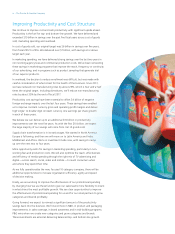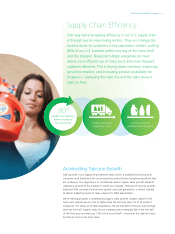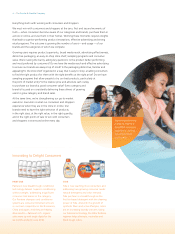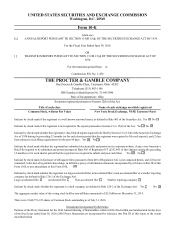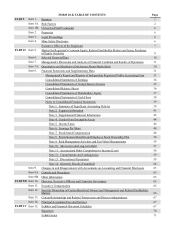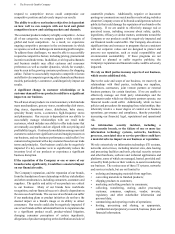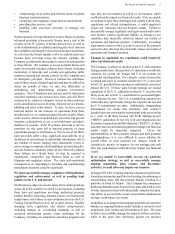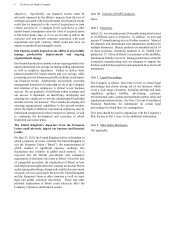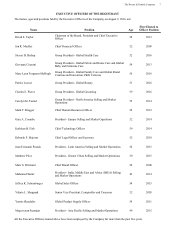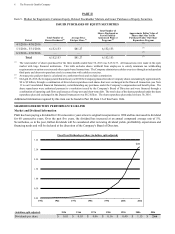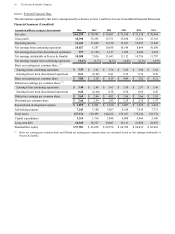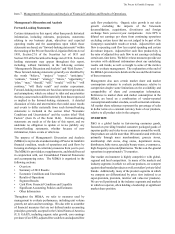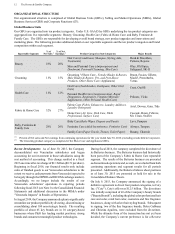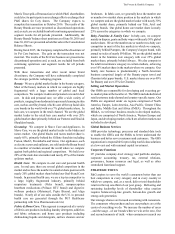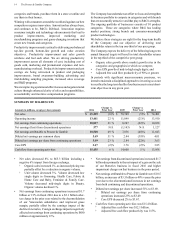Proctor and Gamble 2016 Annual Report Download - page 18
Download and view the complete annual report
Please find page 18 of the 2016 Proctor and Gamble annual report below. You can navigate through the pages in the report by either clicking on the pages listed below, or by using the keyword search tool below to find specific information within the annual report.4 The Procter & Gamble Company
respond to competitive moves could compromise our
competitive position and adversely impact our results.
The ability to achieve our business objectives is dependent
on how well we can compete with our local and global
competitors in new and existing markets and channels.
The consumer products industry is highly competitive. Across
all of our categories, we compete against a wide variety of
global and local competitors. As a result, we experience
ongoing competitive pressures in the environments in which
we operate, as well as challenges in maintaining profit margins.
To address these challenges, we must be able to successfully
respond to competitive factors, including pricing, promotional
incentives and trade terms. In addition, evolving sales channels
and business models may affect customer and consumer
preferences as well as market dynamics, which, for example,
may be seen in the growing consumer preference for shopping
online. Failure to successfully respond to competitive factors
and effectively compete in growing sales channels and business
models, particularly e-commerce, could negatively impact our
results.
A significant change in customer relationships or in
customer demand for our products could have a significant
impact on our business.
We sell most of our products via retail customers, which include
mass merchandisers, grocery stores, membership club stores,
drug stores, department stores, distributors, baby stores,
specialty beauty stores, e-commerce, high-frequency stores
and pharmacies. Our success is dependent on our ability to
successfully manage relationships with our retail trade
customers, which includes our ability to offer trade terms that
are mutually acceptable and are aligned with our pricing and
profitability targets. Continued consolidation among our retail
customers could create significant cost and margin pressure on
our business, and our business performance could suffer if we
cannot reach agreement with a key customer based on our trade
terms and principles. Our business could also be negatively
impacted if a key customer were to significantly reduce the
inventory level of our products or experience a significant
business disruption.
If the reputation of the Company or one or more of our
brands erodes significantly, it could have a material impact
on our financial results.
The Company's reputation, and the reputation of our brands,
form the foundation of our relationships with key stakeholders
and other constituencies, including consumers, customers and
suppliers. The quality and safety of our products are critical
to our business. Many of our brands have worldwide
recognition, and our financial success is directly dependent on
the success of our brands. The success of our brands can suffer
if our marketing plans or product initiatives do not have the
desired impact on a brand's image or its ability to attract
consumers. Our results could also be negatively impacted if
one of our brands suffers substantial harm to its reputation due
to a significant product recall, product-related litigation,
changing consumer perceptions of certain ingredients,
allegations of product tampering or the distribution and sale of
counterfeit products. Additionally, negative or inaccurate
postings or comments on social media or networking websites
about the Company or one of its brands could generate adverse
publicity that could damage the reputation of our brands or the
Company. If we are unable to effectively manage real or
perceived issues, including concerns about safety, quality,
ingredients, efficacy or similar matters, sentiments toward the
Company or our products could be negatively impacted and
our financial results could suffer. Our Company also devotes
significant time and resources to programs that are consistent
with our corporate values and are designed to protect and
preserve our reputation, such as social responsibility and
environmental sustainability. If these programs are not
executed as planned or suffer negative publicity, the
Company's reputation and financial results could be adversely
impacted.
We rely on third parties in many aspects of our business,
which creates additional risk.
Due to the scale and scope of our business, we must rely on
relationships with third parties, including our suppliers,
distributors, contractors, joint venture partners or external
business partners, for certain functions. If we are unable to
effectively manage our third party relationships and the
agreements under which our third party partners operate, our
financial results could suffer. Additionally, while we have
policies and procedures for managing these relationships, they
inherently involve a lesser degree of control over business
operations, governance and compliance, thereby potentially
increasing our financial, legal, reputational and operational
risk.
An information security incident, including a
cybersecurity breach, or the failure of one or more key
information technology systems, networks, hardware,
processes, associated sites or service providers could have
a material adverse impact on our business or reputation.
We rely extensively on information technology (IT) systems,
networks and services, including internet sites, data hosting
and processing facilities and tools, physical security systems
and other hardware, software and technical applications and
platforms, some of which are managed, hosted, provided and/
or used by third-parties or their vendors, to assist in conducting
our business. The various uses of these IT systems, networks
and services include, but are not limited to:
• ordering and managing materials from suppliers;
• converting materials to finished products;
• shipping products to customers;
• marketing and selling products to consumers;
• collecting, transferring, storing, and/or processing
customer, consumer, employee, vendor, investor,
regulatory, and other stakeholder information and
personal data;
• summarizing and reporting results of operations;
• hosting, processing and sharing, as appropriate,
confidential and proprietary research, business plans and
financial information;


